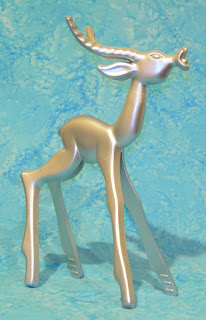(Like I said, interesting.)
No molds invoke more mystery, or invite more questions than the Modernistic Deer. Indeed, their very existence is a mystery: these highly stylized creatures are completely unlike anything else in the Breyer line. Where did they come from? Why were they made? And the near-identical "Don Manning" Deer – what are those about?
I have reason to believe, however, that they might have been released earlier than that. In a very early, but undated price list from Mission Supply House, a well-known mail-order company, the Modernistic Buck, Doe and Fighting Stallion appear, but the Mustang and Five-Gaiter do not.
Selling brand new molds and releases in advance of their "official" release dates is nothing new for Breyer. The Stud Spider, Legionario III, and Classic Andalusian Family, and even the folded-wood Corral were all sold in holiday catalogs several months before they appeared in Dealer Catalogs or Collector’s Manuals.
So it’s completely possible that the Modernistic Deer (and the Fighting Stallion) could have been on store shelves in time for the holiday gift-giving season in 1960. (The Deer were advertised in the Dealer Catalog, coincidentally, as ideal for "Christmas and other special occasions." Hmm.)
While the explanation for the absence of the Mustang and Five-Gaiter mold could be, quite simply, that they weren’t quite ready yet (Breyer has a long history of that sort of thing, too) there’s another reason why I think the early release theory is plausible: there’s a strong case to be made that Breyer may have bought the molds from another company, ready to go.
Let’s tackle the Nosco Plastics part, first.
Nosco Plastics was a division of the National Organ Supply Company of Erie, Pennsylvania. In 1934, National Organ Supply instituted the Nosco Division to make injected molded plastic parts for electric organs, but the division quickly grew into much more than that. By the early 1950s, they were best known as the company that produced the first plastic toy soldiers (the ones heavily advertised in comic books) and Cracker Jack prizes.
In 1955, Nosco was sold to Saunders Tool & Die of Aurora, Illinois – another custom molder with eyes on the Post-War plastic toy boom – and the Nosco disappeared. I’m assuming that the sale included all of the molds that Nosco had in their inventory, which would have included the Modernistic Buck and Doe. Bucks and Does that don’t have the Nosco mark would date to this period, I'm assuming.
So, how did these molds end up in Breyer hands? That, and the other half of this story, coming soon!




2 comments:
Wow! I find the modernistic buck and doe fascinating.
Sorry I didn't get the chance to say hello or a friendly conversation. Crowed lines in hot humid conditions,is no place for friendly banter. However it was nice seeing you again.
my family received a set of modernistic deer in clear and brown from the saline ford plastics company in the early 60s. i don't know how ford got the mold- but if anyone knows where i can get more of these i'd be most grateful- we still have several and i'd love to complete the set for sentimental reasons-thanks!
jmclella@msn.com
Post a Comment